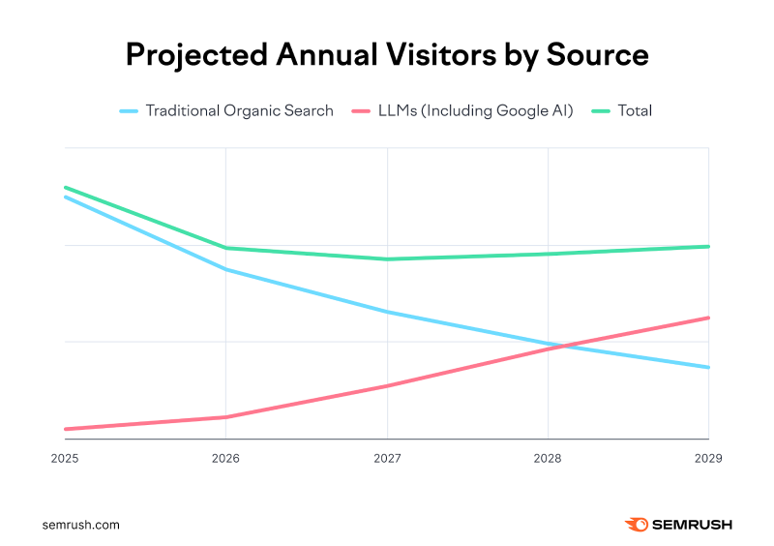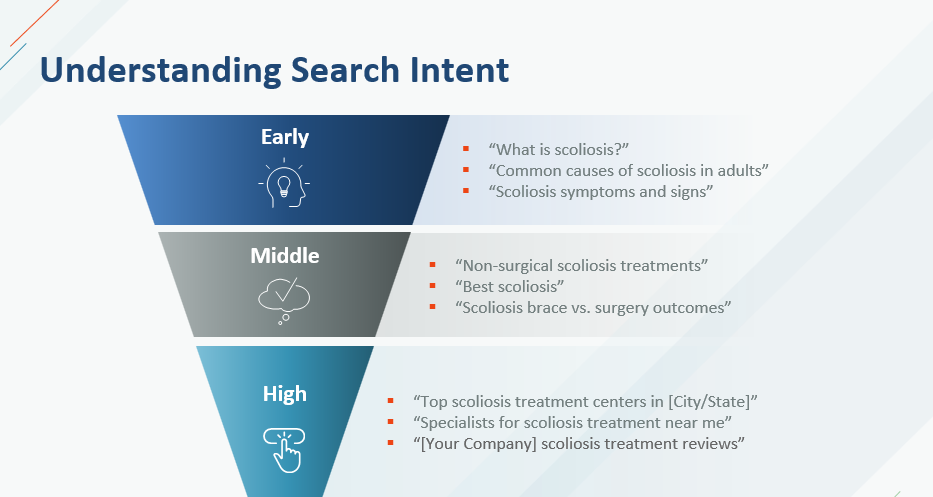AI Search Engine Optimization: What Life Science Marketers Need to Know
AI-powered search is still in its early stages, but it is moving quickly and reshaping the way people find and evaluate companies online. Large Language Models (LLMs) are no longer just powering chatbots — they are driving entire search experiences, delivering conversational answers instead of pages of blue links.

According to SEMrush, AI search visitors are projected to surpass traditional search visitors by 2028.
Even now, these visitors are 4.4 times more valuable than the average search user because they are often further along in their decision-making process. They arrive on your site more informed, vetted, and ready to take action.
For marketers in the life sciences, the implications are clear. AI search engine optimization is not something to wait on. The earlier you adapt, the more firmly you can secure your position in the answers AI delivers.
Prefer to watch instead of read? Check out the video below for a quick overview of how AI is changing search engine optimization for life science marketers, or keep reading for a deeper dive into the strategies and insights shaping the future of AI-driven SEO.
Why AI Search Engine Optimization Matters Now
The brands that move first will gain an advantage that compounds over time. AI models and answer engines learn from the sources they trust now, and those patterns influence future results.
If your company is consistently showing up in AI-generated answers today, you are shaping the training data that will be used tomorrow.
The main reasons to start now include:
- High-intent traffic: AI search visitors often behave like bottom-of-funnel leads in Google.
- Increased engagement: They have already done research and are ready for deeper conversations.
- Authority building: LLM-powered search systems pull from sources with a history of reliability.
- First-mover advantage: Waiting until AI search is mainstream means competing against leaders already trusted by answer engines.
How AI Search Behavior Is Evolving
Traditional search queries tend to be short, averaging just a few words. AI search queries, especially in LLM-powered platforms like ChatGPT or Claude, often exceed 20 words and contain far more context.
A typical AI prompt might be:
“What are the best non-surgical scoliosis treatments and how effective are they compared to surgery?”
This query does not just name a topic — it describes the user’s age, preferences, and the type of comparison they are seeking. That richer detail changes which content is selected and how it is presented. AI can surface highly relevant content even if it is buried deep in Google’s results.
Shifting Your Content Strategy
The fundamentals of SEO such as quality, relevance, and authority still matter, but you now need to consider three overlapping optimization environments.
- Traditional SEO – Ranking in search engines like Google.
- Answer Engine Optimization (AEO) – Securing placement in instant-answer results from answer engines.
- Generative Engine Optimization (GEO) – Being cited in the responses generated by LLM-powered systems.
Success comes from creating authoritative, accurate, and well-structured content that performs across all three.
Understanding Search Intent Through the Scoliosis Example

In AI search, intent still matters, but the way people express it is different. Instead of moving through the funnel in separate steps, a single AI prompt can mix elements of awareness, consideration, and decision-making.
Here is how scoliosis-related content might break down:
- Awareness: “What is scoliosis?” “Common causes of scoliosis in adults.”
- Consideration: “Non-surgical scoliosis treatments.” “Scoliosis brace vs. surgery outcomes.”
- Decision: “Specialists for scoliosis treatment near me.” “Cost of scoliosis treatment and insurance coverage.”
Covering each stage ensures you are visible to users whether they are just learning about a condition or ready to choose a provider, and it gives AI more reasons to cite you in its recommendations.
Building Your Keyword Universe
AI search engine optimization still relies on keyword signals, but the scope needs to be broader and more intentional. A single core topic in the life sciences might have 100 or more relevant keywords.

The best approach is to:
- Organize those terms into 7 to 9 core topic pages that cover the main themes.
- Support each core page with related subpages that explore specific aspects in detail.
This not only strengthens your authority in Google’s eyes, but also makes your content more attractive to LLM-driven generative engines and answer engines.
Creating Content That AI Will Trust
When AI chooses which content to surface or cite, it looks for signals of credibility, relevance, and clarity. To stand out:
- Include original insights such as proprietary data, case studies, and firsthand expertise.
- Reference credible sources and maintain strict accuracy, especially in regulated industries.
- Use clear structure with headings, summaries, and schema markup so AI can parse your content easily.
- Ensure compliance with industry regulations to avoid being disqualified as a trustworthy source.
Generic, keyword-stuffed copy will not make the cut. AI favors the content that best answers the question with precision and depth.
Keeping Content Fresh and Relevant
Freshness is one of the most powerful signals in AI search. An updated page from last month can outrank an older but better-linked page if it is more aligned with the user’s prompt.
A quarterly update process should include:
- Reviewing high-value pages for outdated information.
- Adding FAQs that address common and emerging questions.
- Updating research, statistics, and regulatory information to reflect the latest standards.
AI Search Engine Optimization Tools to Explore
AI search engine optimization tools make it easier to test and improve your visibility. Here are some worth considering:
- Profound – Tracks brand mentions in AI platforms and answer engines like ChatGPT and Perplexity.
- Semrush – Adds AI visibility insights to its traditional SEO analytics. (We use this one)
- Writesonic – Helps create AI-optimized content for both GEO and AEO.
- Indexly – Speeds indexing and tracks AI discoverability.
- Surfer – Uses AI to structure and optimize content for LLM-friendly formats.
Use these tools to test prompts, identify which sources are cited most often, and determine whether you can replace them with fresher, higher-quality content.
Factors That Increase Your AI Visibility
To improve your chances of appearing in LLM-driven search and answer engines, focus on:
- Earning mentions in reputable publications and industry lists.
- Producing original, comprehensive content that covers topics in depth.
- Structuring pages so AI systems can parse and interpret them easily.
Tracking Your AI Search Performance
Tracking AI visibility is still a blend of manual checks and tool-based insights. Start by:
- Testing prompts in ChatGPT, Perplexity, and Google AI Overviews.
- Using private browsing to avoid personalization in results.
- Adding “AI Search” as a lead source in your forms and CRM.
Three Ways to Earn AI Citations
Be the Source
Create the definitive, most complete resource on your topic. This means going beyond surface-level explanations and incorporating original research, industry insights, detailed examples, and visuals where appropriate. AI models favor citing the most thorough, trustworthy answer they can find. If your guide is the go-to reference in your space, it has a much higher chance of being selected.
Tactics:
- Develop “pillar” content that covers the topic end-to-end.
- Include expert commentary and data from credible sources.
- Use clear formatting, headings, and summaries so AI can parse it easily.
Be Included
If you cannot own the top spot yet, aim to get your brand or content mentioned in authoritative sources that AI already trusts and cites. This can be through partnerships, PR, guest content, or thought leadership in recognized industry publications.
Tactics:
- Contribute guest articles or interviews to respected websites in your industry.
- Earn inclusion in “best of” lists, awards, and industry resource pages.
- Build relationships with journalists, editors, and influencers who produce the content AI cites.
Replace the Source
Monitor which pages or sources are currently being cited in AI results for your target queries, and then create content that is fresher, more complete, and more relevant to the query. AI systems prioritize the most up-to-date and helpful responses, so well-executed updates can displace older citations.
Tactics:
- Identify the pages currently cited in AI-generated answers for your keywords.
- Fill in gaps, add updated research, and make the content easier to consume.
- Promote and build links to your updated content to accelerate adoption by AI models.
Helping Leadership Understand the Shift
One of the biggest hurdles in adopting AI search engine optimization is gaining buy-in from leadership. For many executives, SEO already feels like a complex, moving target — adding AI into the mix can sound like an entirely new initiative that demands extra budget, resources, or staff.
The key is to frame AI SEO as an evolution of your current efforts, not a separate strategy. It builds on the same principles you are already using, but adapts them for the way search is changing.
Points to communicate to leadership:
We can track and measure it. With AI search engine optimization tools and manual testing, you can show when and where your brand appears in AI-generated answers and tie that visibility to leads or inquiries.
It’s not a replacement for SEO — it’s an extension. The same quality content, technical optimization, and authority building that drive Google rankings also position your brand for AI citations.
The audience is different — and more valuable. AI search visitors are often more informed, more specific in their needs, and further along in the buying process. According to SEMrush, they are 4.4x more valuable than traditional search visitors.
Visibility is shifting, not disappearing. A drop in Google clicks doesn’t necessarily mean fewer leads. Some of that traffic is moving to AI-generated answers where brand mentions and citations carry the trust factor for buyers.
Early investment compounds over time. Large Language Models and answer engines “remember” trusted sources. Securing citations now increases your chance of being referenced in future AI results, even as models evolve.
Next Steps for Life Science Marketers
- Audit your SEO foundation.
- Map your keywords by intent stage.
- Develop authoritative content for both GEO and AEO.
- Track AI visibility manually and with AI search engine optimization tools.
- Build brand authority through PR and partnerships.
- Keep your highest-value pages fresh.
Bottom line:
LLM-powered search, answer engines, and generative engines are reshaping how people find information. Brands that commit to AI search engine optimization now by being authoritative, relevant, and consistently visible will lead as AI becomes the default path to discovery.
If you would like to assess your readiness or plan an optimization roadmap, we would be happy to talk. As a full-service life sciences marketing agency, we can also help with website design, content strategy, and broader marketing needs.
